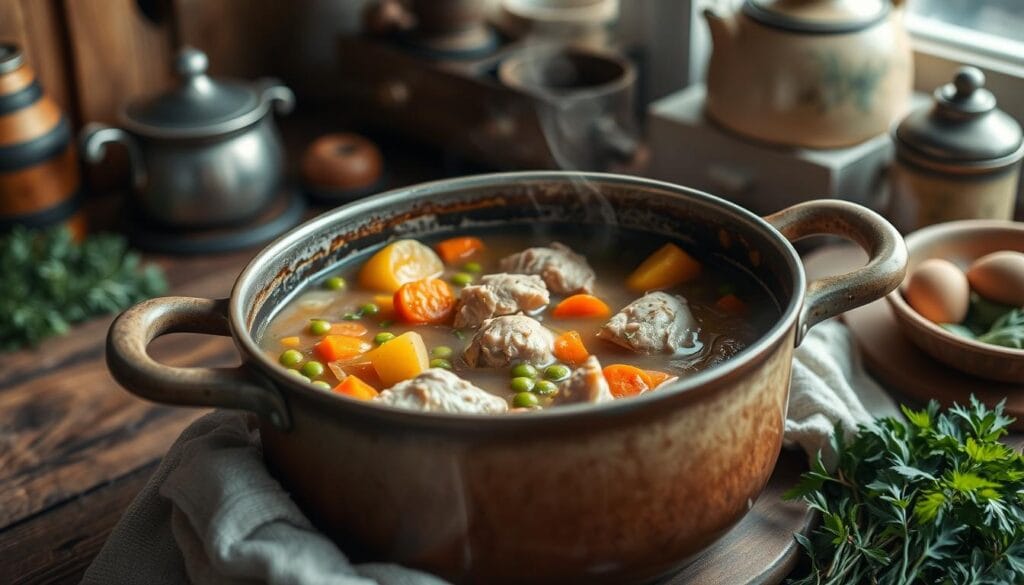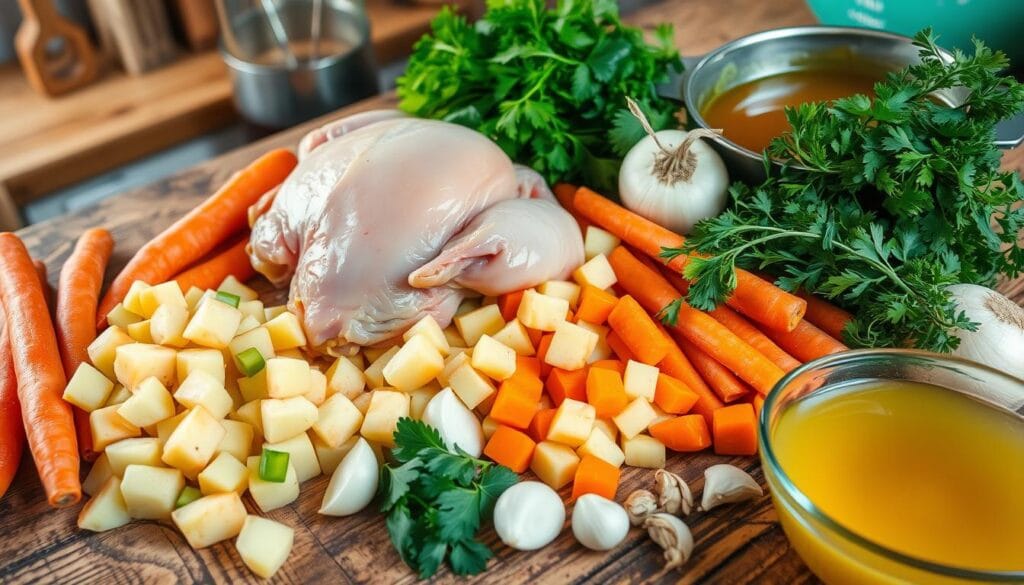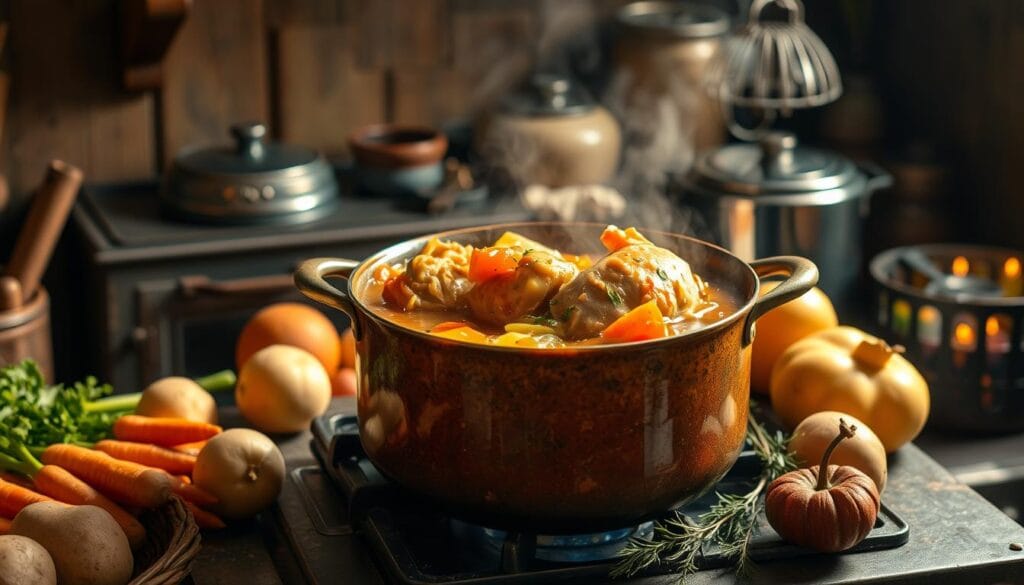Homemade chicken stew brings back childhood memories. The smell of simmering chicken and vegetables warms any cold evening. It’s more than a meal; it’s a family tradition passed down through generations.
When winter hits, nothing beats a warm chicken stew. Each bite tells a story of love and tradition. Our recipe will become a favorite in your home.
Table of contents
The Heritage Behind Traditional Chicken Stew
Grandma’s chicken stew is a treasure from American family traditions. Each family adds their own twist to cooking, making meals that warm our hearts and connect us to our past.

Classic chicken stew started with clever home cooks. They made tasty meals from what they had, even during hard times like the Great Depression. They focused on both taste and nutrition.
Origins of Farm-to-Table Stewing
How did people make stew back then? Families in the country cooked with what they had. They used:
- Locally raised chickens
- Homegrown vegetables
- Seasonal produce from family gardens
- Preserved meats and pantry staples
Grandma’s Secret Cooking Methods
“Slow cooking brings out the soul of the ingredients,” my grandmother would say.
Grandmothers cooked stews slowly, letting flavors grow. They used cast-iron pots and simmered for hours. This made meals that were both rich and satisfying.
Evolution of Classic Stew Recipes
Chicken stew has changed over time. From Hoover Stew in the Depression to today’s fancy versions, it’s always been about being smart, flavorful, and nourishing.
| Era | Stew Characteristics | Key Ingredients |
|---|---|---|
| 1930s | Budget-friendly | Canned vegetables, cheap meats |
| 1950s | Comfort food | Fresh vegetables, farm chicken |
| Today | Gourmet adaptation | Organic ingredients, international spices |
Today, cooks keep the old traditions alive but add their own flair. This keeps grandma’s chicken stew a beloved dish for families everywhere.
Essential Ingredients for Perfect Chicken Stew
To make a classic chicken stew, pick ingredients that add depth and flavor. Knowing what to add for flavor makes your stew special.

Start with top-notch protein. Chicken thighs are best for their tender meat and great taste. Here are the key ingredients to make your stew stand out:
- Protein Base
- Boneless, skinless chicken thighs (2 lbs)
- Alternative: Chicken breasts for leaner option
- Aromatic Vegetables
- Large onion, finely chopped
- 5 garlic cloves, minced
- 4 large carrots, sliced
- 2 celery stalks, chopped
Seasoning is key for a rich flavor. Your spice mix should include:
- Dried herbs: rosemary, oregano, thyme
- Ground spices: cumin, black pepper
- Bay leaves for depth
- Red pepper flakes for subtle heat
| Ingredient Category | Recommended Quantity | Purpose |
|---|---|---|
| Chicken | 2 lbs | Primary protein source |
| Potatoes | 2 lbs | Starch and texture |
| Chicken Broth | 2 1/2 cups | Liquid base and flavor |
| Fresh Herbs | 3 tbsp | Finishing brightness |
Pro tip: Adding fresh herbs like dill or parsley at the end adds a burst of flavor.
For more creative takes, you can explore unique slow-cooker chicken recipes, which emphasize ease without compromising flavor
“A great stew is about layering flavors and allowing ingredients to speak for themselves.” – Traditional Cooking Wisdom
Old Fashioned Chicken Stew Recipe
Making a tasty homemade chicken stew takes patience and skill. This old fashioned recipe brings warmth and comfort to your table. It’s a classic dish loved by many for generations.

Preparation Tips and Techniques
For a great slow cooked chicken stew, follow these tips:
- Cut chicken breasts into 1-inch pieces (approximately 500g)
- Chop vegetables uniformly for consistent cooking
- Use fresh ingredients for maximum flavor
- Brown chicken in batches to develop rich taste
Step-by-Step Cooking Instructions
Here’s how to make a perfect homemade chicken stew:
- Sear chicken pieces in olive oil until golden brown
- Remove chicken and sauté vegetables in the same pan
- Create a flavor base with onions, garlic, carrots, and celery
- Add chicken back to the pot
- Pour in broth and seasonings
- Simmer until chicken is tender and vegetables are cooked
Traditional Seasoning Guide
Enhance your stew with these classic seasonings:
- Salt and ground black pepper
- Thyme
- Rosemary
- Oregano
- Bay leaves
“A great stew is about layering flavors and allowing ingredients to develop depth and richness.”
Pro tip: To thicken your stew, mix cornstarch with water. This keeps the flavor rich and the texture perfect.
Nutritional Highlights
Each serving of this stew has about 170 calories. It’s full of nutrients. The recipe makes 9 servings. You can store it in the fridge for 2-3 days or freeze it for a month.
Selecting the Best Cuts of Chicken
Choosing the right chicken cuts is key for a traditional farm fresh chicken stew. In the old days, cooks knew that different parts of the chicken could change the flavor and texture of their dish.
Chicken thighs reign supreme for stew. Their rich, dark meat gives a deeper flavor and stays tender during long cooking. Unlike chicken breasts, which can dry out, thighs keep moisture and taste richer.
- Bone-in thighs: Add extra depth to your broth
- Boneless, skinless thighs: Convenient and quick to prepare
- Whole chicken pieces: Traditional method from how stew was made in old days
When picking chicken for your stew, keep these points in mind:
- Choose farm-fresh chickens with minimal processing
- Make sure the chicken reaches 165°F for safety
- Opt for naturally raised, free-range chickens for better flavor
“The secret to an exceptional stew lies in selecting the right chicken cut,” noted traditional home cooks.
Historically, cooks used every chicken part, even wings and backs. This made the stew flavorful and showed off their creativity in cooking farm fresh chicken stew.
The Art of Creating Rich, Flavorful Broth
Making a tasty homemade chicken stew starts with a great broth. The broth is the heart of the stew, turning simple ingredients into a delicious meal.
Homemade Stock Basics
Your homemade chicken stew needs a strong stock to make every bite better. Begin with quality chicken bones. Use a mix of neck, back, and wing bones for the best flavor and gelatin.
- Use fresh chicken bones from a whole chicken
- Roast bones before simmering for deeper flavor
- Collect bones from previous meals to maximize resources
Aromatics and Herbs Selection
Choosing the right ingredients is key to a flavorful stew. Focus on classic aromatic combinations to enhance your stew’s taste.
| Aromatic | Flavor Profile | Recommended Quantity |
|---|---|---|
| Onions | Sweet, deep base flavor | 2 medium onions |
| Carrots | Subtle sweetness | 3-4 medium carrots |
| Celery | Herbal undertones | 2-3 stalks |
Proper Simmering Techniques
The secret to a perfect homemade chicken stew is gentle, patient cooking. Keep the temperature low to let flavors develop without losing protein.
“A great broth whispers its flavors, it never shouts.” – Traditional Cooking Wisdom
- Keep temperature between 185-200°F
- Skim any foam that rises to the surface
- Simmer uncovered for the last 30 minutes to concentrate flavors
Pro tip: A tablespoon of white miso paste can add an extraordinary depth of umami to your homemade chicken stew’s broth.
Mastering the Perfect Stew Consistency
Making the perfect one pot chicken stew is more than just picking ingredients. It’s about getting that rich, mouthwatering consistency. Knowing how to thicken your chicken stew can turn a simple dish into a work of art.
Thickening your chicken stew needs some smart techniques:
- Create a cornstarch slurry by mixing cold water with cornstarch
- Prepare a traditional roux using butter and flour
- Mash some cooked potatoes back into the stew
- Simmer uncovered to naturally reduce liquid
“The perfect stew should coat the back of a spoon – not too thin, not too thick.”
Professional chefs say to use 2 tablespoons of butter and 2 tablespoons of flour for a roux in your stew. For a dairy-free option, try plant-based butter or chicken broth.
Be patient. Let your stew simmer uncovered for 10-20 minutes. This lets it thicken and get those deep, rich flavors. Stir now and then to avoid sticking and keep it even.
- Ideal cooking time: 40-55 minutes
- Recommended thickening agents: cornstarch, flour, mashed potatoes
- Best consistency: Thick enough to coat a spoon
Try out different methods to find your ideal stew thickness. Remember, the more you practice, the better you’ll get!
Fresh Vegetables and Their Role
Making a farm fresh chicken stew needs careful veggie selection and prep. Knowing how stew was made in old days helps you make a tasty, traditional meal. It honors classic cooking ways.
Vegetables turn a simple chicken stew into a hearty, healthy meal. Each veggie adds its own flavor and texture to your dish.
Seasonal Vegetable Combinations
Different seasons bring unique veggies for your chicken stew:
- Summer: Fresh corn, zucchini, bell peppers
- Fall: Root veggies like parsnips, turnips
- Winter: Hearty potatoes, carrots, squash
- Spring: Tender peas, asparagus, green onions
Proper Cutting and Sizing Guide
Uniform veggie cuts ensure even cooking and texture in your stew. Aim for these standard sizes:
| Vegetable | Recommended Cut Size | Cooking Time |
|---|---|---|
| Potatoes | 3/4 inch cubes | 25-30 minutes |
| Carrots | 1/2 inch rounds | 20-25 minutes |
| Celery | 1/4 inch slices | 15-20 minutes |
| Onions | 1/2 inch pieces | 10-15 minutes |
Cooking Times for Different Vegetables
In traditional farm fresh chicken stew, veggies are added at the right time. Harder veggies like carrots and potatoes go in first. Delicate veggies like peas are added near the end.
“The secret to a perfect stew is understanding each vegetable’s cooking time and texture.” – Traditional Home Cook
Remember, veggies add flavor and nutrition to your chicken stew. Try different seasonal produce to make your own version of this classic dish.
Storage and Reheating Methods
Keeping your slow cooked chicken stew fresh is important. It can be a convenient meal for days after cooking with the right storage.
Refrigeration is key to keeping your stew tasty. Here are some storage tips:
- Store in airtight containers
- Refrigerate for up to 3-4 days
- Cool completely before storing
- Use shallow containers for quick cooling
Freezing can make your stew last even longer. Here are some freezing tips:
- Use freezer-safe containers or bags
- Freeze for up to 3 months
- Label containers with date of preparation
- Leave slight space for expansion
“Proper storage means enjoying your delicious stew weeks after cooking!” – Culinary Experts
Reheating needs gentle care to keep the stew’s flavor and texture:
- Thaw overnight in refrigerator
- Reheat on stovetop over medium heat
- Stir occasionally to prevent burning
- Add splash of chicken broth if needed
| Storage Method | Duration | Recommended Technique |
|---|---|---|
| Refrigeration | 3-4 days | Airtight container |
| Freezing | Up to 3 months | Freezer-safe container |
Pro tip: The flavors of your slow cooked chicken stew often improve after a day or two, making leftovers even more delicious!
Serving Suggestions and Pairings
Turning your comfort food chicken stew into a memorable meal is all about the right sides. The right pairings can make your stew go from good to great. It’s all about creating a complete dining experience that pleases your senses.
Traditional Side Dishes
Here are some classic sides to go with your chicken stew:
- Crusty artisan bread for soaking up rich broth
- Steamed green vegetables
- Simple mixed green salad
- Roasted seasonal vegetables
Bread and Accompaniments
The choice of bread can really show the difference between chicken stew and casserole. Stews go well with:
- Homemade buttermilk biscuits
- Rustic cornbread
- Sourdough slices
- Herb-infused focaccia
Wine Pairing Recommendations
Finding the right wine can make your chicken stew feel fancy. Here are some top picks:
| Wine Type | Flavor Profile | Recommended Pairing |
|---|---|---|
| Chardonnay | Medium-bodied, buttery | Creamy chicken stews |
| Pinot Noir | Light, fruity | Herb-rich chicken stews |
| Sauvignon Blanc | Crisp, acidic | Lighter chicken stews |
“The perfect stew is not just about the recipe, but how you present and enjoy it.” – Culinary Experts
Pro tip: Add fresh parsley or chives on top of your chicken stew. It adds a bright touch that boosts both looks and taste.
Troubleshooting Common Stewing Issues
Making the perfect old fashioned chicken stew can be tricky. Every cook faces problems that can ruin a meal. Let’s look at ways to solve common stewing issues.
When making your chicken stew, texture and consistency matter a lot. Here are some tips to fix common cooking problems:
- Tough Chicken Dilemma: Use dark meat like chicken thighs for tender results. Dark meat has more fat, staying juicy longer.
- Watery Broth Solution: To thicken chicken stew, try these methods:
- Make a cornstarch slurry
- Simmer uncovered to reduce liquid
- Use potato starch as an alternative thickener
- Vegetable Texture Management: Add veggies in stages for the right doneness. Harder root veggies need longer cooking than softer ones.
“The secret to a perfect stew is patience and understanding your ingredients.” – Culinary Wisdom
Seasoning is key to great flavor in your stew. Taste and adjust seasonings near the end of cooking. Salt and herbs get richer as the stew cooks.
With these tips, you can turn cooking challenges into tasty successes.
Conclusion
Your classic chicken stew is more than a meal. It’s a tradition passed down through generations. This comfort food allows you to try many flavors while keeping the dish hearty and satisfying.
Whether you stick to a traditional recipe or try new ingredients, your stew shows your cooking style. Its flexibility makes it great for family dinners, weekend meals, or quick weeknight dinners.
Mastering chicken stew takes time and practice. With each try, you get better at seasoning and balancing flavors. Your kitchen becomes a place of creativity and connection, where simple ingredients make a nourishing meal that brings people together.
Keep exploring and improving your stew-making skills. Enjoy the joy of cooking and the warmth a well-made comfort food chicken stew brings to your table. Your culinary journey is just starting, and each stew has its own story.
FAQ
What makes an old-fashioned chicken stew different from other chicken dishes?
An old-fashioned chicken stew is made by slow-cooking chicken and vegetables in a rich broth. This method creates a hearty meal with deep flavors. It’s a one-pot dish that’s full of taste.
What are the best cuts of chicken to use for stew?
Chicken thighs are the best for stew because they stay tender and flavorful. You can use boneless, skinless thighs or bone-in pieces for more flavor. But, chicken breasts should be cooked carefully to avoid drying out.
How do I thicken my chicken stew?
You can thicken chicken stew in several ways. Mix cold water with cornstarch to make a slurry. Or, use flour and fat to make a roux. You can also mash cooked potatoes and add them back to the stew.
Another method is to add heavy cream towards the end of cooking. Or, simmer it uncovered to reduce and thicken naturally.
What’s the difference between chicken stew and chicken casserole?
Chicken stew is cooked on the stovetop and has a liquid consistency. Chicken casserole, on the other hand, is baked in the oven and is thicker. Stews focus on a rich broth, while casseroles have a layered structure.
How long can I store chicken stew?
Chicken stew can be refrigerated for up to 4 days in an airtight container. For longer storage, freeze it for up to 6 months. When reheating, thaw it overnight in the fridge if it’s frozen.
Reheat it gently on the stovetop, adding a bit of broth or water if it’s too thick.
What are the essential herbs and seasonings for a traditional chicken stew?
Traditional seasonings include thyme, rosemary, sage, salt, and pepper. Bay leaves are also used. These herbs add a classic flavor that enhances the chicken and vegetables.
Fresh herbs like parsley can be added at the end for extra flavor and brightness.
Can I make chicken stew with different vegetables?
Yes, you can! Traditional vegetables are potatoes, carrots, celery, and onions. But, you can use seasonal vegetables too. Summer might have corn, while winter stews have root vegetables.
Make sure to cut vegetables into uniform sizes for even cooking. Add firmer vegetables earlier.
What are the best side dishes to serve with chicken stew?
Serve chicken stew with crusty bread, biscuits, or cornbread to soak up the broth. A simple green salad or steamed vegetables are also great sides. For wine, choose a medium-bodied white like Chardonnay or a light red like Pinot Noir.

Leave a Reply
You must be logged in to post a comment.